This morning we had a walking tour around Essaouira with a woman named Rashida, who was quite literally the first Moroccan woman we have really interacted with. Generally speaking, while there are women cooking in the guesthouses we have stayed in or cleaning etc in the hotels, we have not really been able to interact with women in Morocco. In most places all the shop keeps are men, all the guides, drivers and hosts are men, and the women are largely unseen. Rashida is also a bit of an oddity as she is a Gen X lady who has a university education and worked as a teacher for many years, so we were very hopeful of a lot of information from her. Our first port of call on our walking tour (pun intended) was the harbour where much of the local fishing industry is carried out.
Our first port of call on our walking tour (pun intended) was the harbour where much of the local fishing industry is carried out. 
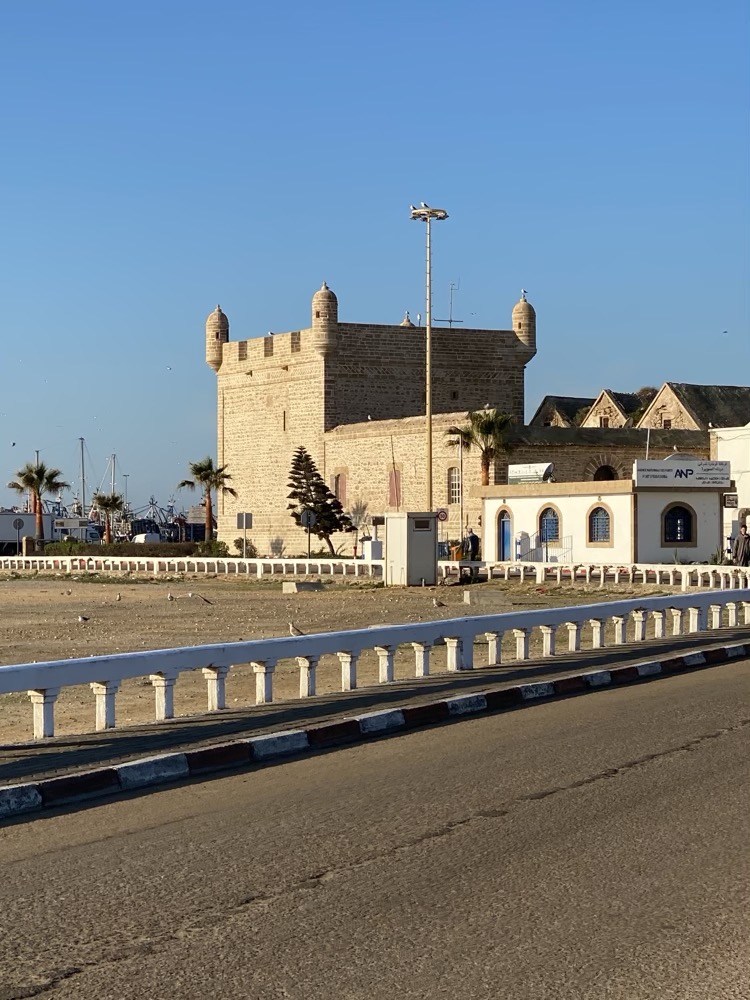 Local fishermen will bring in their catch here and a bustling and busy wholesale fish auction occur every morning – except this morning, which is Sunday. Historically, Essaouira has been occupied since prehistoric times as the bay is fairly adequately protected by Mogador Island, which makes it a very peaceful and protected harbour from the strong Atlantic winds.
Local fishermen will bring in their catch here and a bustling and busy wholesale fish auction occur every morning – except this morning, which is Sunday. Historically, Essaouira has been occupied since prehistoric times as the bay is fairly adequately protected by Mogador Island, which makes it a very peaceful and protected harbour from the strong Atlantic winds.
Essaouira has long been one of the best anchorages on the entire Moroccan coast. A Carthaginian navigator named Hanno wrote of coming here in the 5thC BC to establish a trading post, which made it a strategically important location over the following 2500 years.. Boats here, like in many other countries, are female – and will have a name painted on them. Many of the names are Spanish, Portuguese, or even English, so we could see the Christina or the Maria nearby. The fishermen here are required to paint their boats blue, as they believed that flies are not able to see the blue colour..?
Boats here, like in many other countries, are female – and will have a name painted on them. Many of the names are Spanish, Portuguese, or even English, so we could see the Christina or the Maria nearby. The fishermen here are required to paint their boats blue, as they believed that flies are not able to see the blue colour..?
While we were at the dock, a small boat pulled in a 14′ shark, Rashida called it a ‘clown shark’ but with it’s very long tail fin, it looked like an endangered thresher shark to most of the divers in our group. This shark is destined for the fish markets and will be eaten.

 In the 16thC, Essaouira was occupied by Portugal, ad the King at the time, Manuel I ordered a fortress to be built here – it was called the Castelo Real de Mogador – Essaouira was known as Mogador up until the 1960s. By that time, the Portuguese had control of six Moroccan coastal towns and had built a stand-alone fortress in each town from the start of their occupation in the mid 15thC Most of them were short-lived, being only held for between 5-25 years… by 1541, the fortress at Agadir had fallen to the Saardians (that was the Arab-Moroccan dynasty that ruled Morocco from 1549-1659) and the Portuguese had to abandon all the settlements they had occupied managing only to hold onto Tangier, Cuta and Mazagan.
In the 16thC, Essaouira was occupied by Portugal, ad the King at the time, Manuel I ordered a fortress to be built here – it was called the Castelo Real de Mogador – Essaouira was known as Mogador up until the 1960s. By that time, the Portuguese had control of six Moroccan coastal towns and had built a stand-alone fortress in each town from the start of their occupation in the mid 15thC Most of them were short-lived, being only held for between 5-25 years… by 1541, the fortress at Agadir had fallen to the Saardians (that was the Arab-Moroccan dynasty that ruled Morocco from 1549-1659) and the Portuguese had to abandon all the settlements they had occupied managing only to hold onto Tangier, Cuta and Mazagan.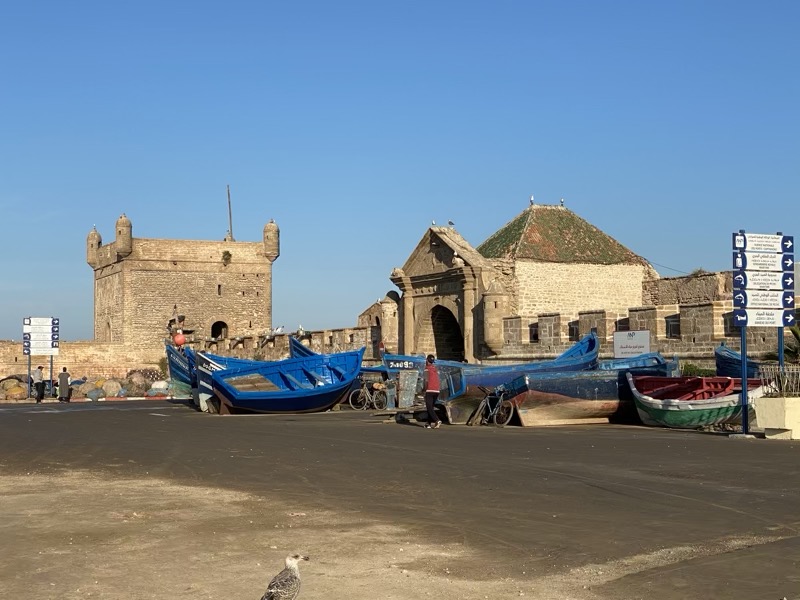


During the following century, several European powers including Spain, England, the Netherlands and France all tried to conquer the region without success and Essaouira remained a haven for the sugar exports of sugar and molasses, and as favourite anchorage for pirates. Yarrrr. Various parts of the fortifications were built and extended on from that time onwards. The present fortifications were built in the 1700s by various French architects – Rashida tells us Moroccans know how to build things, but are not very good at maintaining them.
Various parts of the fortifications were built and extended on from that time onwards. The present fortifications were built in the 1700s by various French architects – Rashida tells us Moroccans know how to build things, but are not very good at maintaining them.  The triumphal arch that joins the harbour to the fortifications represents several different religions that coexisted in the town at that time – the pilgrim’s Shell of Santiago was for the Christians, particularly Spanish Catholics, below it is a Koranic verse along with an Islamic date of 1184, and further below that are crescents for the ‘fertile moon’ which lies between the Tigress and the Euphrates, and if you look closely there are some small stars of David in the flowers on the lozenge motifs. Essaouira had a large Jewish population here, and they were never persecuted like they were in Europe. It was the only safe haven the Jewish had ever known – however on the formation of Israel after WWII 98% of Essaouira’s Jewish population moved to Israel, leaving only about 40-50 Jewish families here now.
The triumphal arch that joins the harbour to the fortifications represents several different religions that coexisted in the town at that time – the pilgrim’s Shell of Santiago was for the Christians, particularly Spanish Catholics, below it is a Koranic verse along with an Islamic date of 1184, and further below that are crescents for the ‘fertile moon’ which lies between the Tigress and the Euphrates, and if you look closely there are some small stars of David in the flowers on the lozenge motifs. Essaouira had a large Jewish population here, and they were never persecuted like they were in Europe. It was the only safe haven the Jewish had ever known – however on the formation of Israel after WWII 98% of Essaouira’s Jewish population moved to Israel, leaving only about 40-50 Jewish families here now. There is an enormous number of cats in this town – they are all very well fed and very well looked after as they keep down the rat population. Essaouira never suffered from the plague due to their harmonious relationship with cats. Here, they collect the cats and desex them, give them shots and keep them healthy – they then dock the cat’s ear. so the community knows they should feed and look after that cat. Cats without their ear docked are to be avoided as they might be diseased. With the rabies.
There is an enormous number of cats in this town – they are all very well fed and very well looked after as they keep down the rat population. Essaouira never suffered from the plague due to their harmonious relationship with cats. Here, they collect the cats and desex them, give them shots and keep them healthy – they then dock the cat’s ear. so the community knows they should feed and look after that cat. Cats without their ear docked are to be avoided as they might be diseased. With the rabies. 


 The town’s cats don’t really belong to anyone, so the town is dotted with cute little cat houses where the cats can go to curl up out of the wind or the summer heat..
The town’s cats don’t really belong to anyone, so the town is dotted with cute little cat houses where the cats can go to curl up out of the wind or the summer heat..  The old arsenal under the fortifications is now filled with shops.
The old arsenal under the fortifications is now filled with shops. 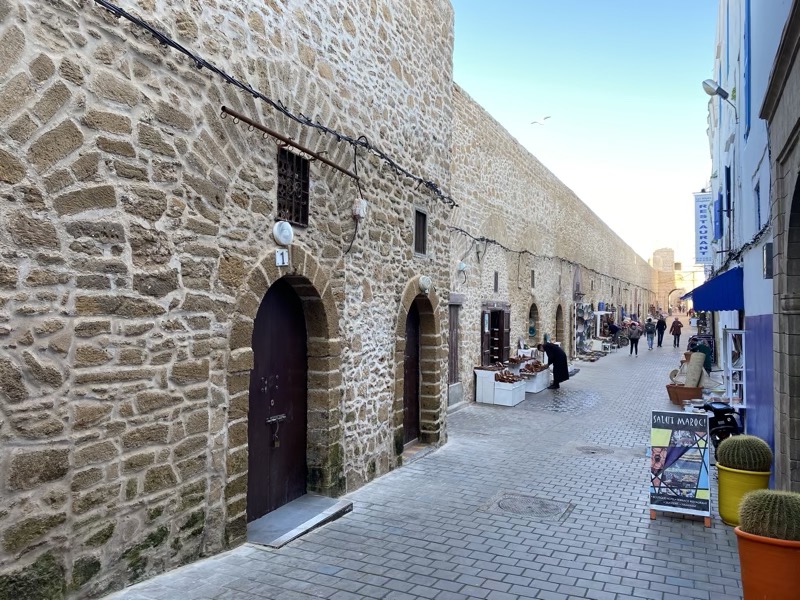
 Looking up towards the battlements. The design of the fortress was such that the sounds would echo through the rounded battlements so that one or two cannon could be fired and it would sound like a dozen or more. It was a fairly effective deterrent from invaders arriving from the sea, however, if they did round the corner…
Looking up towards the battlements. The design of the fortress was such that the sounds would echo through the rounded battlements so that one or two cannon could be fired and it would sound like a dozen or more. It was a fairly effective deterrent from invaders arriving from the sea, however, if they did round the corner…  invaders would be greeted by ‘real Moroccan hospitality’, according to Rashida.
invaders would be greeted by ‘real Moroccan hospitality’, according to Rashida. 
 More fat cats – it’s hard to take photos around this area without them.
More fat cats – it’s hard to take photos around this area without them.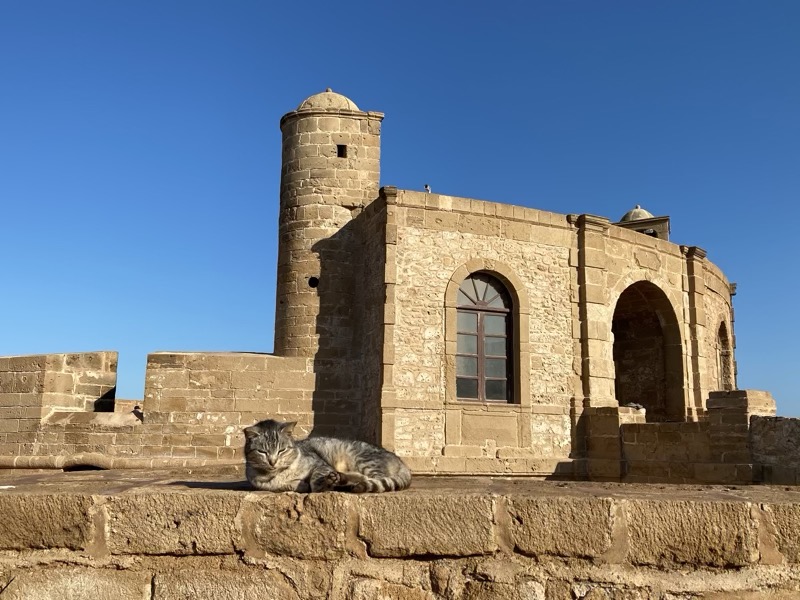
 Some of the canon along the battlement were made/ordered by Carlos III of Spain, others are Danish in origin
Some of the canon along the battlement were made/ordered by Carlos III of Spain, others are Danish in origin



 The medina is much like other towns we have visited, though much more relaxed and laid back. This has become a holiday town for Europeans and has a very European influence in the food, the shopping and the general atmosphere.
The medina is much like other towns we have visited, though much more relaxed and laid back. This has become a holiday town for Europeans and has a very European influence in the food, the shopping and the general atmosphere.  The next place we stopped into was the Centre Artisanal known for its extremely fine handicrafts made from the Thuya timber.
The next place we stopped into was the Centre Artisanal known for its extremely fine handicrafts made from the Thuya timber.  Thuya wood (pronounced two-ya) comes from the Thuya tree (Tetraclinis articulata) which is native only to Morocco…the lovely burled part of the timber is created from a tumour like grown that appears in the tree’s roots.
Thuya wood (pronounced two-ya) comes from the Thuya tree (Tetraclinis articulata) which is native only to Morocco…the lovely burled part of the timber is created from a tumour like grown that appears in the tree’s roots.  The local master craftsman make extremely intricate pieces which have mother of peal, lemonwood, abalone shell and charred timber (to mimic ebony) in ever-increasingly complex patterns and designs. The results are gorgeous.
The local master craftsman make extremely intricate pieces which have mother of peal, lemonwood, abalone shell and charred timber (to mimic ebony) in ever-increasingly complex patterns and designs. The results are gorgeous.

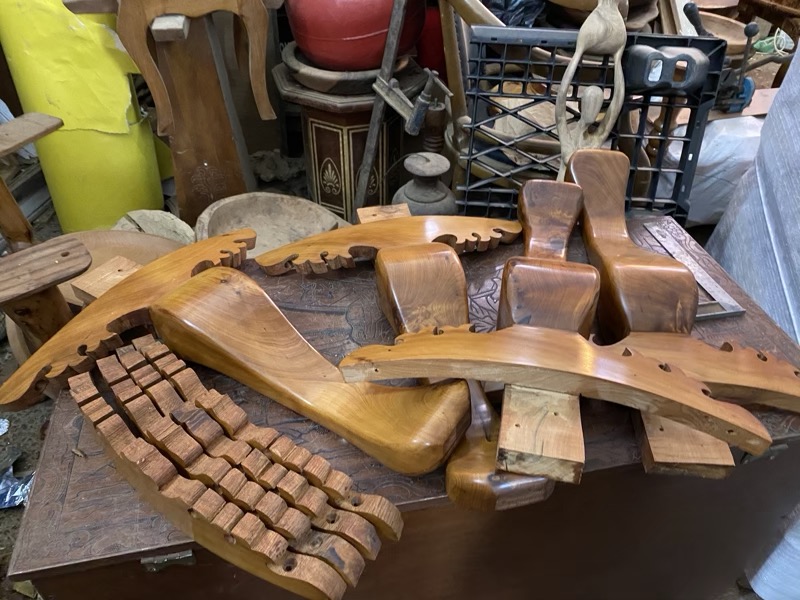 This round table is made of three occasional tables which can be laid out in many different ways to create a zigzag long table or a round table or lotus shape or whatever. It goes for around 16000DH ((AUD$2700). Needless to say, we admired them greatly and left them in the shop!
This round table is made of three occasional tables which can be laid out in many different ways to create a zigzag long table or a round table or lotus shape or whatever. It goes for around 16000DH ((AUD$2700). Needless to say, we admired them greatly and left them in the shop! The various sellers of Thuya wood tend to claim that their industry is sustainable and they are supposed to plant two trees for every one that is cut down, but according to Rashida, the reality is somewhat different and the trees are heading towards being endangered. They take about 30 years to grow to maturity, and they live in a symbiotic relationship with the argan trees… both grow better if planted together.
The various sellers of Thuya wood tend to claim that their industry is sustainable and they are supposed to plant two trees for every one that is cut down, but according to Rashida, the reality is somewhat different and the trees are heading towards being endangered. They take about 30 years to grow to maturity, and they live in a symbiotic relationship with the argan trees… both grow better if planted together.
 It’s gorgeous timber, but most of the pieces are just not things I would use or need. Puzzle boxes, jewellery boxes, trays, bowls, desk accessories, chess sets, domino games and all sorts of beautiful things everywhere..
It’s gorgeous timber, but most of the pieces are just not things I would use or need. Puzzle boxes, jewellery boxes, trays, bowls, desk accessories, chess sets, domino games and all sorts of beautiful things everywhere.. 
 Outside again, we were headed through the medina towards the fish markets which we expected would be relatively quiet on a Sunday.
Outside again, we were headed through the medina towards the fish markets which we expected would be relatively quiet on a Sunday.  Here, I encountered a man selling lots of traditional pigments,.. the white container with the red lid contains the royal ‘Tyrian purple’ favoured by Romans that comes from crushed sea snails – murex.
Here, I encountered a man selling lots of traditional pigments,.. the white container with the red lid contains the royal ‘Tyrian purple’ favoured by Romans that comes from crushed sea snails – murex.  Around the end of the 1stC BC, the Berber king Juba II established a Tyrian purple factory here in Essaouira, where they processed murex and purpura shells found in the rock pools in the harbour and the Iles Purpuraires. This dye was used to colour the purple stripes in the togas worn by the Senators of Imperial Rome until Caligula decreed that only Roman royalty could wear the royal purple.
Around the end of the 1stC BC, the Berber king Juba II established a Tyrian purple factory here in Essaouira, where they processed murex and purpura shells found in the rock pools in the harbour and the Iles Purpuraires. This dye was used to colour the purple stripes in the togas worn by the Senators of Imperial Rome until Caligula decreed that only Roman royalty could wear the royal purple. 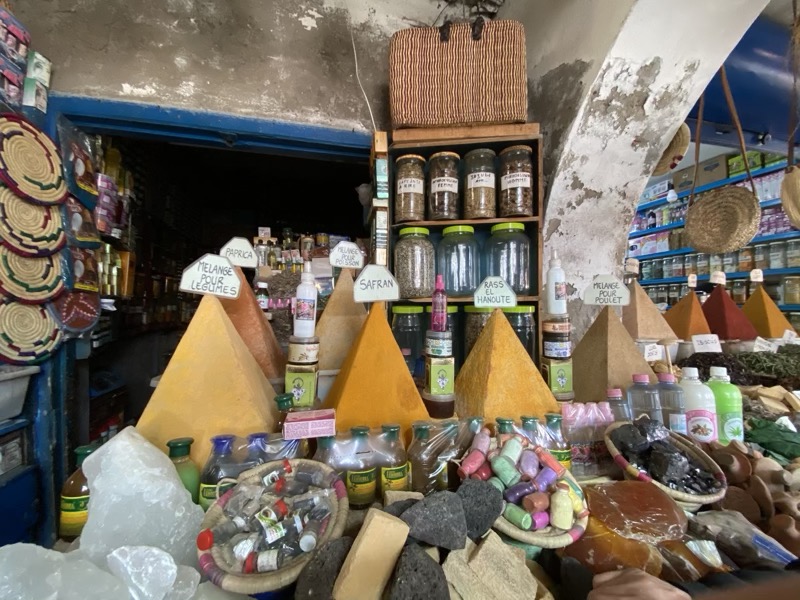 The ground murex is a dark dirty green colour until mixed with water – you can see the purple colour on the edge of the container where it has come into contact with moisture from the sea air.
The ground murex is a dark dirty green colour until mixed with water – you can see the purple colour on the edge of the container where it has come into contact with moisture from the sea air. Fish markety goodness… could be any fishmarket in any country anywhere.
Fish markety goodness… could be any fishmarket in any country anywhere. 
 Next stop was to a workshop for silversmithing – this particular workshop helped deaf people get gainful employment by teaching them to do the fine silver filigree work favoured by the region’s jewellery trade.
Next stop was to a workshop for silversmithing – this particular workshop helped deaf people get gainful employment by teaching them to do the fine silver filigree work favoured by the region’s jewellery trade. 
 We were shown with a touchstone how real silver reacts to acid, and learned a little about traditional Berger designs – most of which seem to be about courtship rituals and symbols of fertility.
We were shown with a touchstone how real silver reacts to acid, and learned a little about traditional Berger designs – most of which seem to be about courtship rituals and symbols of fertility. This Celtic inspired fibular brooch has a large decorative triangular shape attached which is supposed to represent a uterus. It also indicates that a woman is ‘available’… to successfully woo the wearer, her paramour needs to find/have made a matching brooch and hook them together with a heavy silver chain.
This Celtic inspired fibular brooch has a large decorative triangular shape attached which is supposed to represent a uterus. It also indicates that a woman is ‘available’… to successfully woo the wearer, her paramour needs to find/have made a matching brooch and hook them together with a heavy silver chain. Bangles:
Bangles:
 Pendants… oh so many pendants.
Pendants… oh so many pendants.
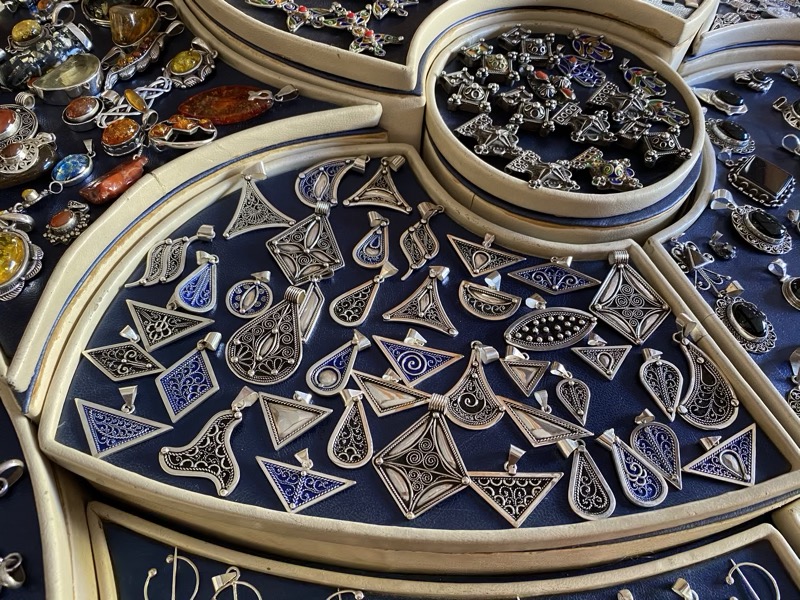 After we checked out the lovely silverwork, we had some quiet time to talk to Rashida about the life of women in Morocco. We had been asking Samirr, ‘Why do we only see men in the shops? How come our hosts in the guesthouses are always men? Where are the women, and can we talk to them?’ A few of us really wanted to talk to an educated woman (someone with good English) who might be prepared to have a frank discussion with us about what it’s like being a woman in an (admittedly fairly progressive) Islamic state.
After we checked out the lovely silverwork, we had some quiet time to talk to Rashida about the life of women in Morocco. We had been asking Samirr, ‘Why do we only see men in the shops? How come our hosts in the guesthouses are always men? Where are the women, and can we talk to them?’ A few of us really wanted to talk to an educated woman (someone with good English) who might be prepared to have a frank discussion with us about what it’s like being a woman in an (admittedly fairly progressive) Islamic state.
The dot points of that conversation went somewhat as follows:
– Morocco has 38% illiteracy, but if you count just the women, that nearly doubles to 65%+
– Most women don’t get an opportunity for education at all, even now, so Rashida being born in the early 70s and university-educated is quite the anomaly – she was sent to school to learn ‘not to be a tomboy’ because she had five older brothers (only three surviving).
– Girls and women are usually ‘kept inside’ from the time of menstruation, so as not to attract the attention of men.
– Arranged marriages are still common, but now women need to appear in court and demonstrate they consent to the marriage (which may or may not be genuine consent).
– The legal age for marriage for girls was increased from 16 to 18 only in 2004, but child marriage still remains quite a problem, especially in rural areas.
– Women have only recently been given the right to divorce their husbands, but men have been able to cast off unwanted wives forever.
– A man can still have three or four wives, but he needs written consent from his existing wives before marrying again… there is literally no mechanism to stop this consent being coerced from the existing wives.
– A widow may remarry but no one would want her as she has been ‘taken and used’ by another man. A man prefers a virginal woman only, so widows tend to remain alone.
– If a woman is raped, her family is likely to offer her as a bride to her rapist. Once ‘used’ she is effectively damaged goods, and no ‘proper family or proper man’ would want her after that. So the only options are to charge the rapist and try to see him sent to jail, or to marry the victim to her rapist so that he might ‘make her respectable’ in the eyes of the village. (Rashida told us a story of an incidence of this occurring to a young 16-year-old victim only 3 years ago, the young girl involved was forced to marry her attacker and unsurprisingly about three or four months later, she committed suicide rather than stay with her ‘husband’ who now had state sanction to keep raping her.
– Children born out of wedlock used to bear their mother’s name either, so the children grew up with the stain of the mother’s sin (or attack) forever. Now they are required to bear the father’s name regardless of the circumstance surrounding their conception, and they have rights to inheritance and upkeep.
– Children automatically stay with their mothers until the age of 12 in the case of a divorce, but the fathers have as much access to their children as they desire – there are no custody battles, the father’s rights supersede the mother’s wishes.
– Domestic abuse is rife, and rarely, if ever, reported.
– Likewise, child abuse and child sexual abuse is never reported – partly because of the stigma and partly because education is so poor, most children are not aware of what is ‘proper’ behaviour from adults, so cases won’t come to light until an abused child has grown up.
– All male children here are circumcised for religious (Jewish) or hygiene reasons, but Morocco never practised female circumcision, ‘that is an African practise, not an Islamic one’.
– Honour killings are rare but unfortunately do still happen in Moroccan Islamic communities.
All up, our half-hour chat with Rashida was very interesting. She was open and frank about her culture as well as her own personal experiences – she is married to a man who had four children from a previous marriage, but was unable to have any children of her own. She is pretty much my age, but already has a handful of step-grandchildren. We were very grateful to have an opportunity to have a talk with her and gain an understanding of the challenges that women face in Morocco… her general feeling is that things are improving, but it’s taking time, and that education and healthcare are the keys to speeding up that process of improvement.
After our chat with Rashida, I met back up with Mr K and we found ourselves a little rooftop terrace for a light lunch. We spent the afternoon doing a bit of shopping and exploring the medina. It wasn’t as busy as we thought the area might be on a Sunday, and we had a much more laid back and friendly shopping experience than we did in Marrakech or Fez.  Back at the riad, we ended up having drinks on the rooftop to finally try and get rid of the excess beers that Mohammed had bought for us, and then it was off for a slightly tipsy stumble into the medina to find a restaurant for a light dinner.
Back at the riad, we ended up having drinks on the rooftop to finally try and get rid of the excess beers that Mohammed had bought for us, and then it was off for a slightly tipsy stumble into the medina to find a restaurant for a light dinner.  We have most of the day here tomorrow too, but other than a few last souvenir type errands, we don’t have any plans other than to finally spend a few hours of this vacation chilling (or catching up on backlog of work that is creeping up on us!). Tomorrow, we transit back to Marrakech for the last two days of our trip.
We have most of the day here tomorrow too, but other than a few last souvenir type errands, we don’t have any plans other than to finally spend a few hours of this vacation chilling (or catching up on backlog of work that is creeping up on us!). Tomorrow, we transit back to Marrakech for the last two days of our trip.

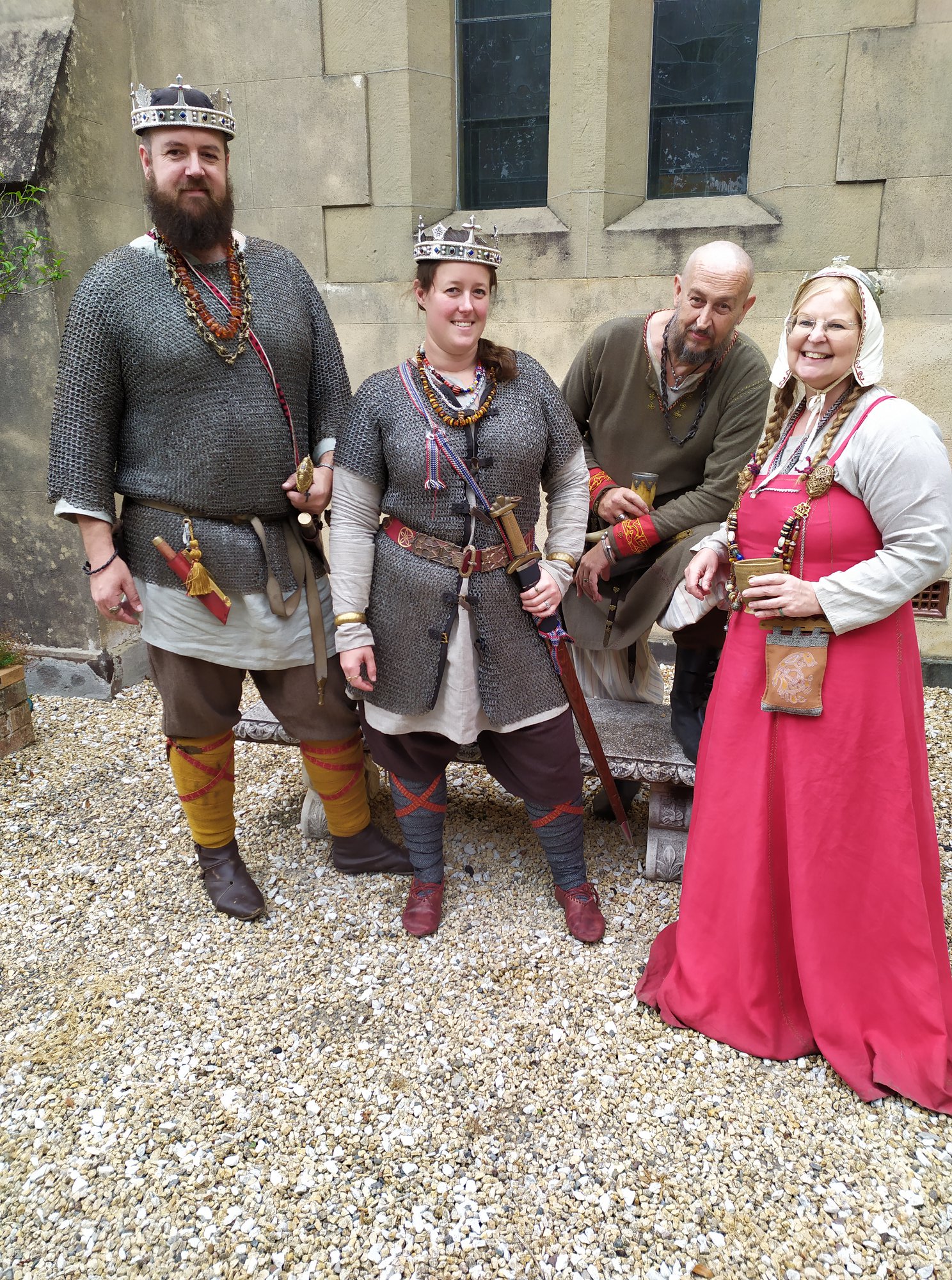

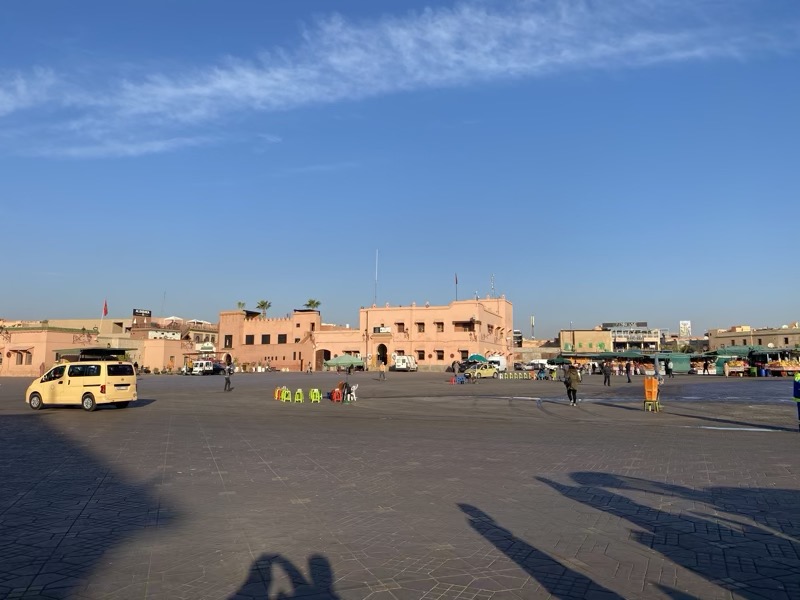 Gone was the soundstage with the makeshift concert venue set up for 40,000 people, gone were most of the snake charmers, monkey handlers, watermen, spruikers, and the heaving tide of humanity that we pushed through when we were here last. The place was just eeriely quiet. This is 10am on a Tuesday in Marrakech’s main square!
Gone was the soundstage with the makeshift concert venue set up for 40,000 people, gone were most of the snake charmers, monkey handlers, watermen, spruikers, and the heaving tide of humanity that we pushed through when we were here last. The place was just eeriely quiet. This is 10am on a Tuesday in Marrakech’s main square!

 Literally, shop after shop, empty.
Literally, shop after shop, empty.


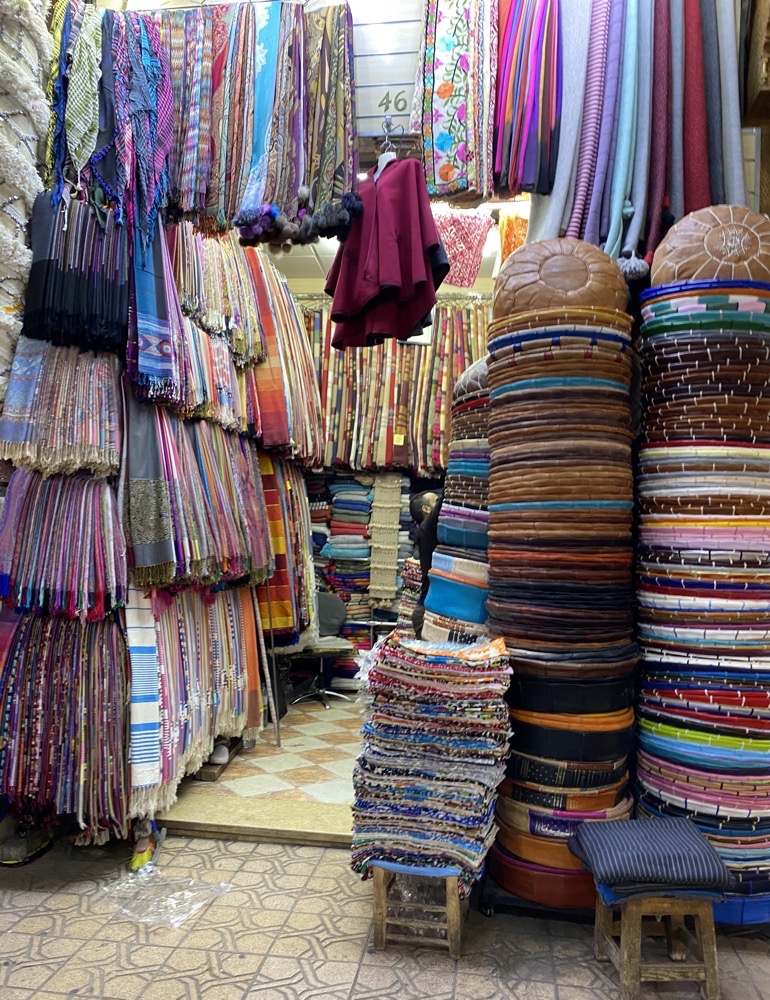 After our rather quiet (and I have to admit, pleasant) trip into the medina, we went to pick up some laundry and do a few errands before it was back to the hotel to play Tetris with the luggage – that’s always my job. Making it all fit in. We normally make sure we don’t buy things that need to be declared when coming back into Australia – it always just reeks of too much effort when you’re shattered from the long haul, but the handicrafts here have defeated us and we have several things that need to be declared, so I have carefully packed those for easy access at customs.
After our rather quiet (and I have to admit, pleasant) trip into the medina, we went to pick up some laundry and do a few errands before it was back to the hotel to play Tetris with the luggage – that’s always my job. Making it all fit in. We normally make sure we don’t buy things that need to be declared when coming back into Australia – it always just reeks of too much effort when you’re shattered from the long haul, but the handicrafts here have defeated us and we have several things that need to be declared, so I have carefully packed those for easy access at customs. Spent the afternoon getting some work underway and packing. After that, though, we were too stuffed to go out to hunt and gather for food. So this is what we ordered from room service at our hotel – a Scillian pizza (with way too much capsicum and missing the requested anchovies), a kefta tagine (which was very tasty) and some Moroccan goats cheese and herb briouats (little filo pastry pies). It was extremely tasty.
Spent the afternoon getting some work underway and packing. After that, though, we were too stuffed to go out to hunt and gather for food. So this is what we ordered from room service at our hotel – a Scillian pizza (with way too much capsicum and missing the requested anchovies), a kefta tagine (which was very tasty) and some Moroccan goats cheese and herb briouats (little filo pastry pies). It was extremely tasty. After this, we managed to find a movie on the TV, (‘Man on a Ledge’, in English) and aimed for an early night. So much for that! Woke up at 04:17 and haven’t been able to get back to sleep which seriously sucks when I am facing a 24hr+ transit starting around 11:00. :/
After this, we managed to find a movie on the TV, (‘Man on a Ledge’, in English) and aimed for an early night. So much for that! Woke up at 04:17 and haven’t been able to get back to sleep which seriously sucks when I am facing a 24hr+ transit starting around 11:00. :/ Our first port of call on our walking tour (pun intended) was the harbour where much of the local fishing industry is carried out.
Our first port of call on our walking tour (pun intended) was the harbour where much of the local fishing industry is carried out. 
 Local fishermen will bring in their catch here and a bustling and busy wholesale fish auction occur every morning – except this morning, which is Sunday. Historically, Essaouira has been occupied since prehistoric times as the bay is fairly adequately protected by Mogador Island, which makes it a very peaceful and protected harbour from the strong Atlantic winds.
Local fishermen will bring in their catch here and a bustling and busy wholesale fish auction occur every morning – except this morning, which is Sunday. Historically, Essaouira has been occupied since prehistoric times as the bay is fairly adequately protected by Mogador Island, which makes it a very peaceful and protected harbour from the strong Atlantic winds.

 In the 16thC, Essaouira was occupied by Portugal, ad the King at the time, Manuel I ordered a fortress to be built here – it was called the Castelo Real de Mogador – Essaouira was known as Mogador up until the 1960s. By that time, the Portuguese had control of six Moroccan coastal towns and had built a stand-alone fortress in each town from the start of their occupation in the mid 15thC Most of them were short-lived, being only held for between 5-25 years… by 1541, the fortress at Agadir had fallen to the Saardians (that was the Arab-Moroccan dynasty that ruled Morocco from 1549-1659) and the Portuguese had to abandon all the settlements they had occupied managing only to hold onto Tangier, Cuta and Mazagan.
In the 16thC, Essaouira was occupied by Portugal, ad the King at the time, Manuel I ordered a fortress to be built here – it was called the Castelo Real de Mogador – Essaouira was known as Mogador up until the 1960s. By that time, the Portuguese had control of six Moroccan coastal towns and had built a stand-alone fortress in each town from the start of their occupation in the mid 15thC Most of them were short-lived, being only held for between 5-25 years… by 1541, the fortress at Agadir had fallen to the Saardians (that was the Arab-Moroccan dynasty that ruled Morocco from 1549-1659) and the Portuguese had to abandon all the settlements they had occupied managing only to hold onto Tangier, Cuta and Mazagan.


 Various parts of the fortifications were built and extended on from that time onwards. The present fortifications were built in the 1700s by various French architects – Rashida tells us Moroccans know how to build things, but are not very good at maintaining them.
Various parts of the fortifications were built and extended on from that time onwards. The present fortifications were built in the 1700s by various French architects – Rashida tells us Moroccans know how to build things, but are not very good at maintaining them.  The triumphal arch that joins the harbour to the fortifications represents several different religions that coexisted in the town at that time – the pilgrim’s Shell of Santiago was for the Christians, particularly Spanish Catholics, below it is a Koranic verse along with an Islamic date of 1184, and further below that are crescents for the ‘fertile moon’ which lies between the Tigress and the Euphrates, and if you look closely there are some small stars of David in the flowers on the lozenge motifs. Essaouira had a large Jewish population here, and they were never persecuted like they were in Europe. It was the only safe haven the Jewish had ever known – however on the formation of Israel after WWII 98% of Essaouira’s Jewish population moved to Israel, leaving only about 40-50 Jewish families here now.
The triumphal arch that joins the harbour to the fortifications represents several different religions that coexisted in the town at that time – the pilgrim’s Shell of Santiago was for the Christians, particularly Spanish Catholics, below it is a Koranic verse along with an Islamic date of 1184, and further below that are crescents for the ‘fertile moon’ which lies between the Tigress and the Euphrates, and if you look closely there are some small stars of David in the flowers on the lozenge motifs. Essaouira had a large Jewish population here, and they were never persecuted like they were in Europe. It was the only safe haven the Jewish had ever known – however on the formation of Israel after WWII 98% of Essaouira’s Jewish population moved to Israel, leaving only about 40-50 Jewish families here now. There is an enormous number of cats in this town – they are all very well fed and very well looked after as they keep down the rat population. Essaouira never suffered from the plague due to their harmonious relationship with cats. Here, they collect the cats and desex them, give them shots and keep them healthy – they then dock the cat’s ear. so the community knows they should feed and look after that cat. Cats without their ear docked are to be avoided as they might be diseased. With the rabies.
There is an enormous number of cats in this town – they are all very well fed and very well looked after as they keep down the rat population. Essaouira never suffered from the plague due to their harmonious relationship with cats. Here, they collect the cats and desex them, give them shots and keep them healthy – they then dock the cat’s ear. so the community knows they should feed and look after that cat. Cats without their ear docked are to be avoided as they might be diseased. With the rabies. 


 The town’s cats don’t really belong to anyone, so the town is dotted with cute little cat houses where the cats can go to curl up out of the wind or the summer heat..
The town’s cats don’t really belong to anyone, so the town is dotted with cute little cat houses where the cats can go to curl up out of the wind or the summer heat..  The old arsenal under the fortifications is now filled with shops.
The old arsenal under the fortifications is now filled with shops. 
 Looking up towards the battlements. The design of the fortress was such that the sounds would echo through the rounded battlements so that one or two cannon could be fired and it would sound like a dozen or more. It was a fairly effective deterrent from invaders arriving from the sea, however, if they did round the corner…
Looking up towards the battlements. The design of the fortress was such that the sounds would echo through the rounded battlements so that one or two cannon could be fired and it would sound like a dozen or more. It was a fairly effective deterrent from invaders arriving from the sea, however, if they did round the corner…  invaders would be greeted by ‘real Moroccan hospitality’, according to Rashida.
invaders would be greeted by ‘real Moroccan hospitality’, according to Rashida. 
 More fat cats – it’s hard to take photos around this area without them.
More fat cats – it’s hard to take photos around this area without them.
 Some of the canon along the battlement were made/ordered by Carlos III of Spain, others are Danish in origin
Some of the canon along the battlement were made/ordered by Carlos III of Spain, others are Danish in origin



 The medina is much like other towns we have visited, though much more relaxed and laid back. This has become a holiday town for Europeans and has a very European influence in the food, the shopping and the general atmosphere.
The medina is much like other towns we have visited, though much more relaxed and laid back. This has become a holiday town for Europeans and has a very European influence in the food, the shopping and the general atmosphere.  The next place we stopped into was the Centre Artisanal known for its extremely fine handicrafts made from the Thuya timber.
The next place we stopped into was the Centre Artisanal known for its extremely fine handicrafts made from the Thuya timber.  Thuya wood (pronounced two-ya) comes from the Thuya tree (Tetraclinis articulata) which is native only to Morocco…the lovely burled part of the timber is created from a tumour like grown that appears in the tree’s roots.
Thuya wood (pronounced two-ya) comes from the Thuya tree (Tetraclinis articulata) which is native only to Morocco…the lovely burled part of the timber is created from a tumour like grown that appears in the tree’s roots.  The local master craftsman make extremely intricate pieces which have mother of peal, lemonwood, abalone shell and charred timber (to mimic ebony) in ever-increasingly complex patterns and designs. The results are gorgeous.
The local master craftsman make extremely intricate pieces which have mother of peal, lemonwood, abalone shell and charred timber (to mimic ebony) in ever-increasingly complex patterns and designs. The results are gorgeous.

 This round table is made of three occasional tables which can be laid out in many different ways to create a zigzag long table or a round table or lotus shape or whatever. It goes for around 16000DH ((AUD$2700). Needless to say, we admired them greatly and left them in the shop!
This round table is made of three occasional tables which can be laid out in many different ways to create a zigzag long table or a round table or lotus shape or whatever. It goes for around 16000DH ((AUD$2700). Needless to say, we admired them greatly and left them in the shop! The various sellers of Thuya wood tend to claim that their industry is sustainable and they are supposed to plant two trees for every one that is cut down, but according to Rashida, the reality is somewhat different and the trees are heading towards being endangered. They take about 30 years to grow to maturity, and they live in a symbiotic relationship with the argan trees… both grow better if planted together.
The various sellers of Thuya wood tend to claim that their industry is sustainable and they are supposed to plant two trees for every one that is cut down, but according to Rashida, the reality is somewhat different and the trees are heading towards being endangered. They take about 30 years to grow to maturity, and they live in a symbiotic relationship with the argan trees… both grow better if planted together.
 It’s gorgeous timber, but most of the pieces are just not things I would use or need. Puzzle boxes, jewellery boxes, trays, bowls, desk accessories, chess sets, domino games and all sorts of beautiful things everywhere..
It’s gorgeous timber, but most of the pieces are just not things I would use or need. Puzzle boxes, jewellery boxes, trays, bowls, desk accessories, chess sets, domino games and all sorts of beautiful things everywhere.. 
 Outside again, we were headed through the medina towards the fish markets which we expected would be relatively quiet on a Sunday.
Outside again, we were headed through the medina towards the fish markets which we expected would be relatively quiet on a Sunday.  Here, I encountered a man selling lots of traditional pigments,.. the white container with the red lid contains the royal ‘Tyrian purple’ favoured by Romans that comes from crushed sea snails – murex.
Here, I encountered a man selling lots of traditional pigments,.. the white container with the red lid contains the royal ‘Tyrian purple’ favoured by Romans that comes from crushed sea snails – murex.  Around the end of the 1stC BC, the Berber king Juba II established a
Around the end of the 1stC BC, the Berber king Juba II established a  The ground murex is a dark dirty green colour until mixed with water – you can see the purple colour on the edge of the container where it has come into contact with moisture from the sea air.
The ground murex is a dark dirty green colour until mixed with water – you can see the purple colour on the edge of the container where it has come into contact with moisture from the sea air. Fish markety goodness… could be any fishmarket in any country anywhere.
Fish markety goodness… could be any fishmarket in any country anywhere. 
 Next stop was to a workshop for silversmithing – this particular workshop helped deaf people get gainful employment by teaching them to do the fine silver filigree work favoured by the region’s jewellery trade.
Next stop was to a workshop for silversmithing – this particular workshop helped deaf people get gainful employment by teaching them to do the fine silver filigree work favoured by the region’s jewellery trade. 
 We were shown with a touchstone how real silver reacts to acid, and learned a little about traditional Berger designs – most of which seem to be about courtship rituals and symbols of fertility.
We were shown with a touchstone how real silver reacts to acid, and learned a little about traditional Berger designs – most of which seem to be about courtship rituals and symbols of fertility. This Celtic inspired fibular brooch has a large decorative triangular shape attached which is supposed to represent a uterus. It also indicates that a woman is ‘available’… to successfully woo the wearer, her paramour needs to find/have made a matching brooch and hook them together with a heavy silver chain.
This Celtic inspired fibular brooch has a large decorative triangular shape attached which is supposed to represent a uterus. It also indicates that a woman is ‘available’… to successfully woo the wearer, her paramour needs to find/have made a matching brooch and hook them together with a heavy silver chain. Bangles:
Bangles: Pendants… oh so many pendants.
Pendants… oh so many pendants.
 After we checked out the lovely silverwork, we had some quiet time to talk to Rashida about the life of women in Morocco. We had been asking Samirr, ‘Why do we only see men in the shops? How come our hosts in the guesthouses are always men? Where are the women, and can we talk to them?’ A few of us really wanted to talk to an educated woman (someone with good English) who might be prepared to have a frank discussion with us about what it’s like being a woman in an (admittedly fairly progressive) Islamic state.
After we checked out the lovely silverwork, we had some quiet time to talk to Rashida about the life of women in Morocco. We had been asking Samirr, ‘Why do we only see men in the shops? How come our hosts in the guesthouses are always men? Where are the women, and can we talk to them?’ A few of us really wanted to talk to an educated woman (someone with good English) who might be prepared to have a frank discussion with us about what it’s like being a woman in an (admittedly fairly progressive) Islamic state. Back at the riad, we ended up having drinks on the rooftop to finally try and get rid of the excess beers that Mohammed had bought for us, and then it was off for a slightly tipsy stumble into the medina to find a restaurant for a light dinner.
Back at the riad, we ended up having drinks on the rooftop to finally try and get rid of the excess beers that Mohammed had bought for us, and then it was off for a slightly tipsy stumble into the medina to find a restaurant for a light dinner.  We have most of the day here tomorrow too, but other than a few last souvenir type errands, we don’t have any plans other than to finally spend a few hours of this vacation chilling (or catching up on backlog of work that is creeping up on us!). Tomorrow, we transit back to Marrakech for the last two days of our trip.
We have most of the day here tomorrow too, but other than a few last souvenir type errands, we don’t have any plans other than to finally spend a few hours of this vacation chilling (or catching up on backlog of work that is creeping up on us!). Tomorrow, we transit back to Marrakech for the last two days of our trip. Maybe Australian needs more camels on their beaches…
Maybe Australian needs more camels on their beaches… Our next stop to break up the drive north was at a women’s co-operative that makes argan oil products from the nuts of the argan tree. This very professional and (deliberately) clinical looking lady showed us how the ladies broke apart the stones from the fruti of the argan trees to get the kernels out to grind into a thick brown paste.
Our next stop to break up the drive north was at a women’s co-operative that makes argan oil products from the nuts of the argan tree. This very professional and (deliberately) clinical looking lady showed us how the ladies broke apart the stones from the fruti of the argan trees to get the kernels out to grind into a thick brown paste. 


 From these kernels, they make various edible products – a cooking/dipping oil, a argain oil paste (which tastes something liek a cross between peanut butter and nutella; as well as a large range of cosmetics.
From these kernels, they make various edible products – a cooking/dipping oil, a argain oil paste (which tastes something liek a cross between peanut butter and nutella; as well as a large range of cosmetics. The argan oil comes only from Morocco and is said to have amazing anti-ageing properties, as well as being fantastic for your hair and nails and cracked heels and all of it.
The argan oil comes only from Morocco and is said to have amazing anti-ageing properties, as well as being fantastic for your hair and nails and cracked heels and all of it.  Weirdly, at home, you see lots of Moroccan coconut oil shampoos and conditions lining the shelves of supermarkets. This appears to be a totally fabricated thing. Morocco is not known for its coconut industry – their palms are predominantly date palms and their primary cosmetic oil is argan – which tends towards being very expensive back home. Oh well, consumers are always suckers for a good marketing campaign. I picked up a small bottle of leave in conditioning hair treatment, and I’m kinda hoping I don’t love it, because buying more is going to be a real bitch!
Weirdly, at home, you see lots of Moroccan coconut oil shampoos and conditions lining the shelves of supermarkets. This appears to be a totally fabricated thing. Morocco is not known for its coconut industry – their palms are predominantly date palms and their primary cosmetic oil is argan – which tends towards being very expensive back home. Oh well, consumers are always suckers for a good marketing campaign. I picked up a small bottle of leave in conditioning hair treatment, and I’m kinda hoping I don’t love it, because buying more is going to be a real bitch! Eventually, we reached our destination for the next two nights- Essaouira, which on the Atlantic on Morocco’s west coast. It’s a very popular tourist destination with Europeans, who largely come here for the beaches, fishing, kitesurfing, and other summer holiday stuff. Until the 1960s, Essaouira was generally known by its Portuguese name, Mogador, which we have seen written all over the places still.
Eventually, we reached our destination for the next two nights- Essaouira, which on the Atlantic on Morocco’s west coast. It’s a very popular tourist destination with Europeans, who largely come here for the beaches, fishing, kitesurfing, and other summer holiday stuff. Until the 1960s, Essaouira was generally known by its Portuguese name, Mogador, which we have seen written all over the places still. 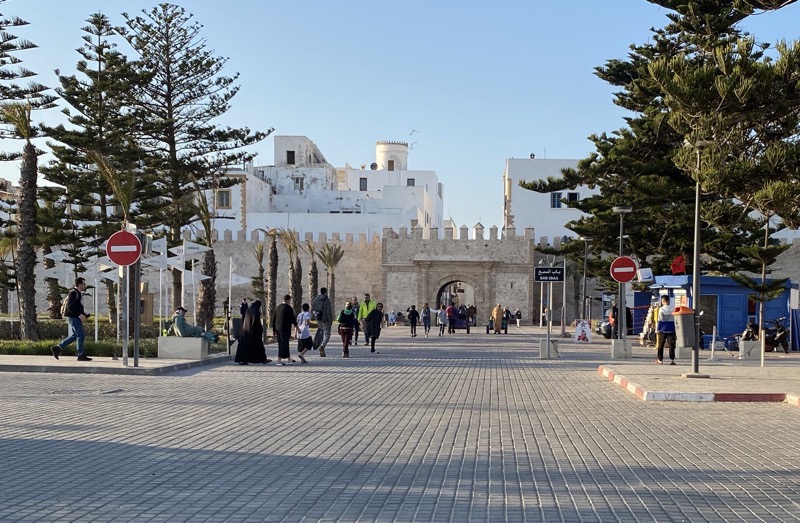 The ramparts of the medina were built in the 1700s. There was a Roman settlement here, this area is where the Tyrian purple dye used to come from that was used to dye the robes of Roman senators. It has been inhabited ever since and was occupied by the Portuguese in the middle ages.
The ramparts of the medina were built in the 1700s. There was a Roman settlement here, this area is where the Tyrian purple dye used to come from that was used to dye the robes of Roman senators. It has been inhabited ever since and was occupied by the Portuguese in the middle ages. The medina is wide and airy compared to Fez or Marrakech – and is largely for pedestrian traffic only which is nice after the hectic and chaotic environments there. Mostly, the medina is filled with Riads (we are staying right in the medina), restaurants, art galleries and handicraft shops… it feels like the Montville or Leura of Morocco!.
The medina is wide and airy compared to Fez or Marrakech – and is largely for pedestrian traffic only which is nice after the hectic and chaotic environments there. Mostly, the medina is filled with Riads (we are staying right in the medina), restaurants, art galleries and handicraft shops… it feels like the Montville or Leura of Morocco!. 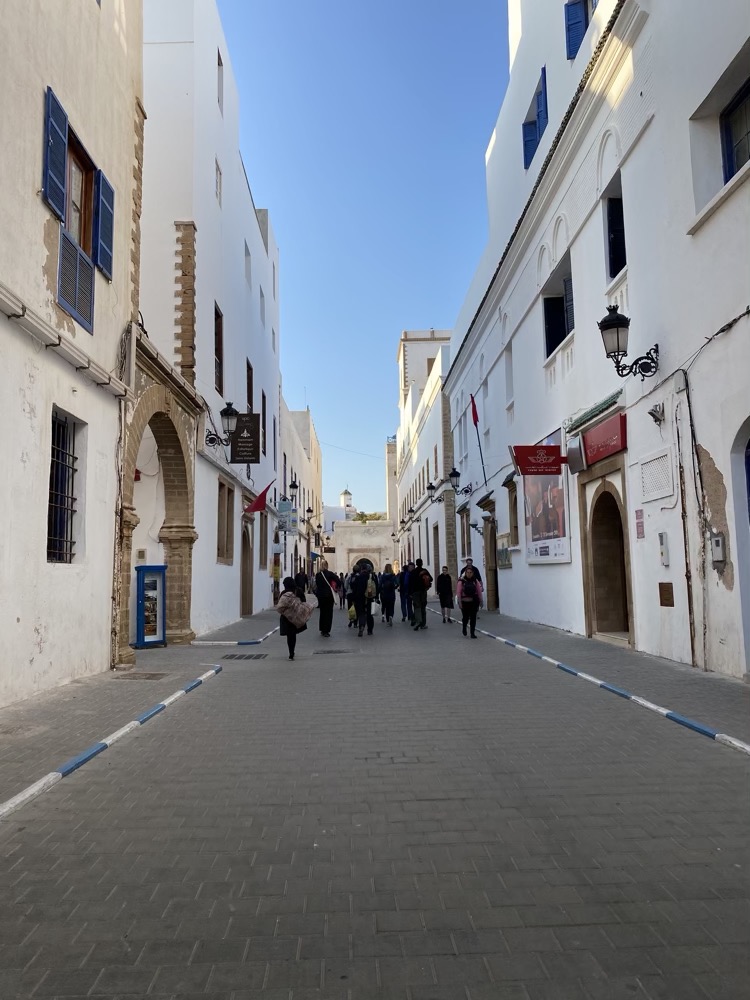
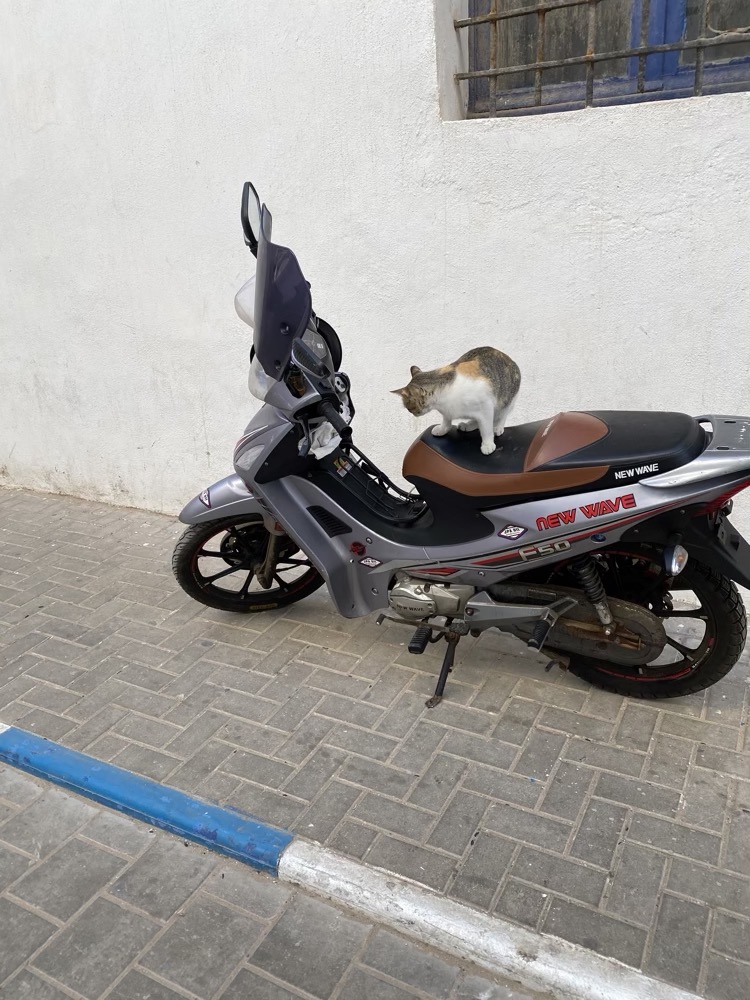

 We checked into our lovely Riad with a gorgeous little courtyard in the centre and then headed straight to the rooftop terrace to have a few beers – this was a complete necessity at this point..
We checked into our lovely Riad with a gorgeous little courtyard in the centre and then headed straight to the rooftop terrace to have a few beers – this was a complete necessity at this point..

 For you see, we had had the most fortuitous miscommunication with Mohammed, the driver of our minibus who has been with us since we left Marrakech. Samirr had arranged for Mohammed to go buy us some alcohol to take to the desert camp, and each person wrote down what they wanted and we were to pay him when he came back. And, being all Aussies, Kiwis, Canadians and Americans we wrote things down like ‘one six-pack’ and ‘one bottle of red wine’ (with a price range). We didn’t have high hopes on Mohammed’s ability to choose a nice red – but we didn’t expect him to some how mistake a ‘six-pack’ with a slab… so somehow instead of five six packs turning up to have a few quiet ones at the Sahara camp, we had five cartons turn up!
For you see, we had had the most fortuitous miscommunication with Mohammed, the driver of our minibus who has been with us since we left Marrakech. Samirr had arranged for Mohammed to go buy us some alcohol to take to the desert camp, and each person wrote down what they wanted and we were to pay him when he came back. And, being all Aussies, Kiwis, Canadians and Americans we wrote things down like ‘one six-pack’ and ‘one bottle of red wine’ (with a price range). We didn’t have high hopes on Mohammed’s ability to choose a nice red – but we didn’t expect him to some how mistake a ‘six-pack’ with a slab… so somehow instead of five six packs turning up to have a few quiet ones at the Sahara camp, we had five cartons turn up!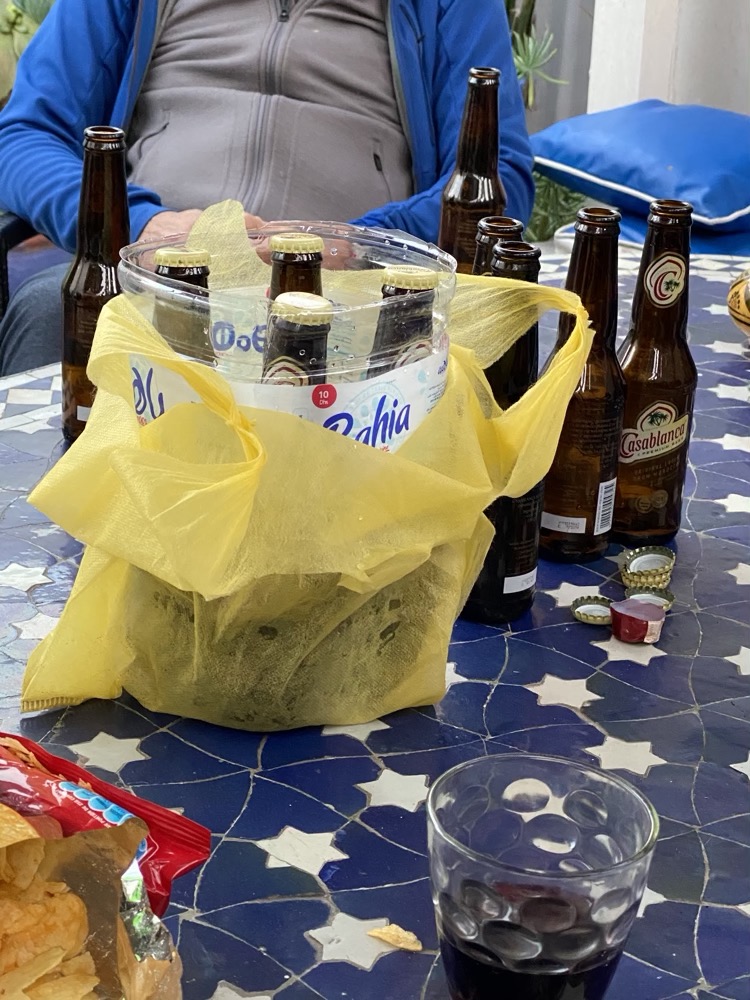
 After a few drinks and a bit of a wind-down, we went for a short stroll into the medina to find some dinner. We all tended towards different fare for the evening and Mr K and I ended up in a very quiet and secluded seafood restaurant enjoying a really nice predominantly European menu with local fresh fish – avocado, shrimp and crab entree, some weird goat cheese spring roll which was absolutely delicious, some grilled john dory fillets and an extremely rich lemon creme brulee (probably the richest thing I’ve eaten in three weeks… only managed about half).
After a few drinks and a bit of a wind-down, we went for a short stroll into the medina to find some dinner. We all tended towards different fare for the evening and Mr K and I ended up in a very quiet and secluded seafood restaurant enjoying a really nice predominantly European menu with local fresh fish – avocado, shrimp and crab entree, some weird goat cheese spring roll which was absolutely delicious, some grilled john dory fillets and an extremely rich lemon creme brulee (probably the richest thing I’ve eaten in three weeks… only managed about half).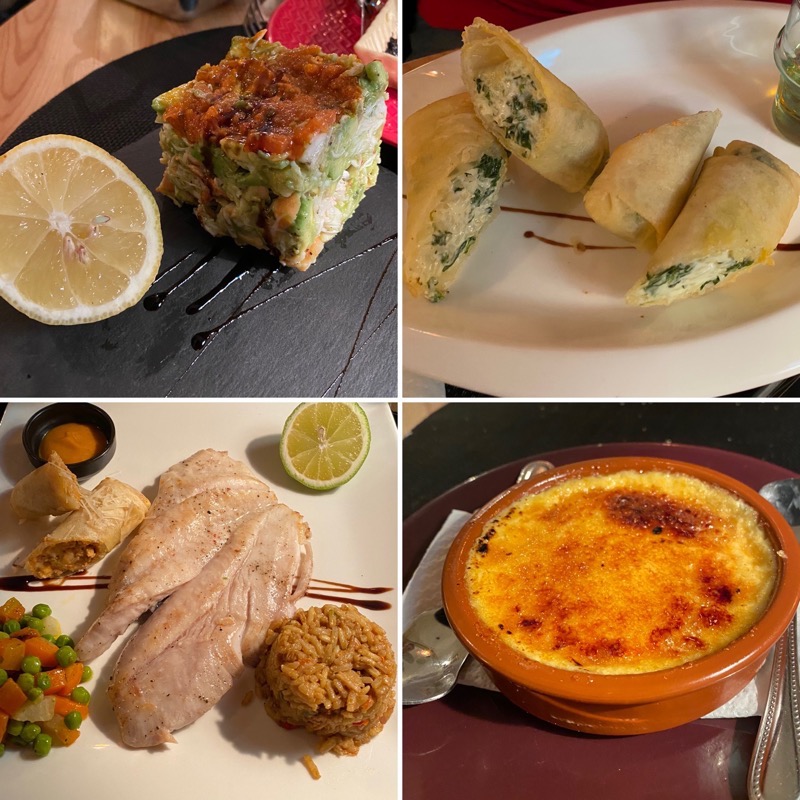 Then back to the Riad, a hot shower and crashed. So tired from a couple of long days on the bus! We have all day in town tomorrow to have a really good look around, I’m currently trying to decide whether to go get a massage or find the local museum to see if they have any interesting Roman objects in their collection.
Then back to the Riad, a hot shower and crashed. So tired from a couple of long days on the bus! We have all day in town tomorrow to have a really good look around, I’m currently trying to decide whether to go get a massage or find the local museum to see if they have any interesting Roman objects in their collection. The early morning light was lovely in the camp, and I was honestly quite surprised that it was nowhere near as cold as I was anticipating. It was about 2C o’night and very low humidity so it didn’t seem that cold at all… or perhaps my barometer for ‘cold’ is off as I am still comparing most things favourably with last years ‘OMFG my hands feel like they’re burning from the car AC set to 16C in Iceland?!?’, type cold? Who knows? Either way, I had a warm night’s sleep in the desert camp and was not too bothered when we got up.
The early morning light was lovely in the camp, and I was honestly quite surprised that it was nowhere near as cold as I was anticipating. It was about 2C o’night and very low humidity so it didn’t seem that cold at all… or perhaps my barometer for ‘cold’ is off as I am still comparing most things favourably with last years ‘OMFG my hands feel like they’re burning from the car AC set to 16C in Iceland?!?’, type cold? Who knows? Either way, I had a warm night’s sleep in the desert camp and was not too bothered when we got up. Mr K playing silly buggers while some of our group were watching the sunrise from a nearby hillock.
Mr K playing silly buggers while some of our group were watching the sunrise from a nearby hillock. For any who are unfamiliar with the geography, this is where Google Maps placed us at the desert came – right close to the Algerian border… and those land mines.
For any who are unfamiliar with the geography, this is where Google Maps placed us at the desert came – right close to the Algerian border… and those land mines.
 Cutting through the really fine sand was like driving through bulldust in central Australia, though not quite so red.
Cutting through the really fine sand was like driving through bulldust in central Australia, though not quite so red. At one point we popped out on the dry, Lake Merzouga. The drivers actually got over 50kmph once they hit the dry lake bed prior to this we were plodding along, still going quite fast for conditions but largely in low range and 2nd or 3rd gear tops.
At one point we popped out on the dry, Lake Merzouga. The drivers actually got over 50kmph once they hit the dry lake bed prior to this we were plodding along, still going quite fast for conditions but largely in low range and 2nd or 3rd gear tops.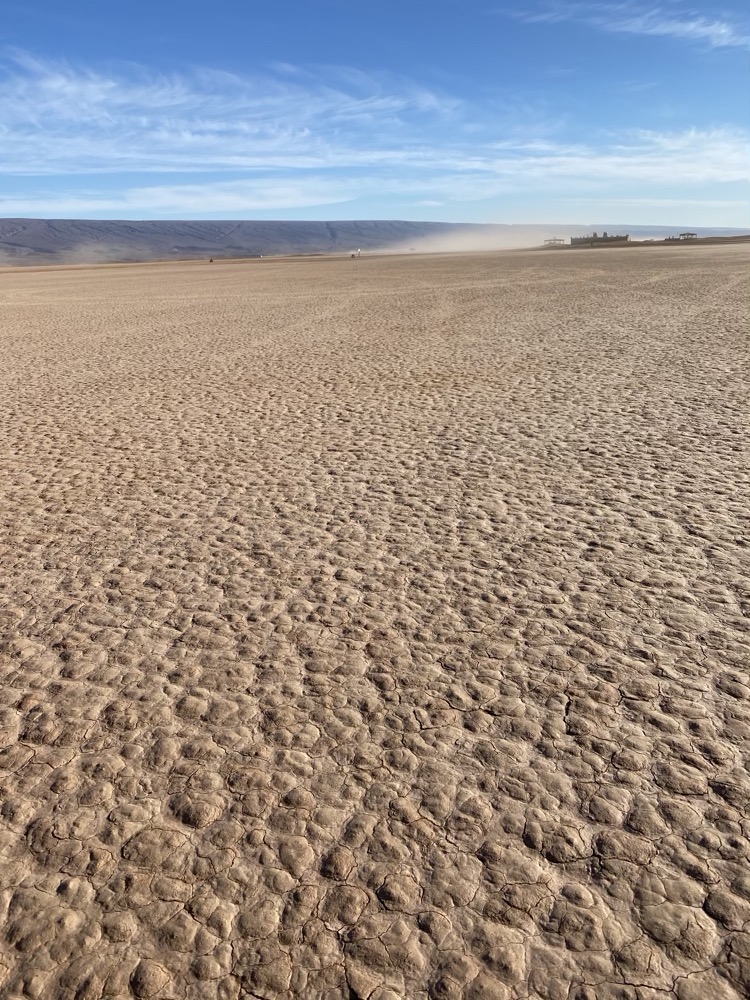

 Another hour or so down the desert, we came to a place covered in rocks where the tourists had, naturally, been building cairns, but where Samirr had us pull up to look at the fossils in nearly every rock you flipped over.
Another hour or so down the desert, we came to a place covered in rocks where the tourists had, naturally, been building cairns, but where Samirr had us pull up to look at the fossils in nearly every rock you flipped over. 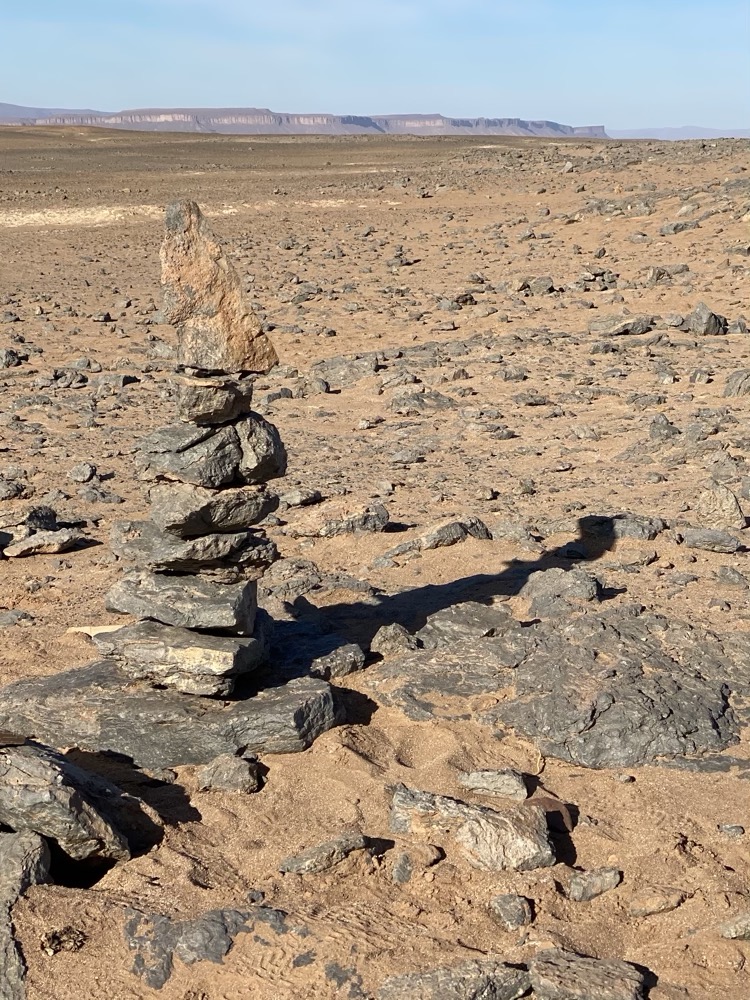 Tess and I kicked over this cairn only to discover the enormous flat rock at the base was covered in fossils. Nearly every rock in this area, no matter how large or small had something fossilised into it.
Tess and I kicked over this cairn only to discover the enormous flat rock at the base was covered in fossils. Nearly every rock in this area, no matter how large or small had something fossilised into it. 
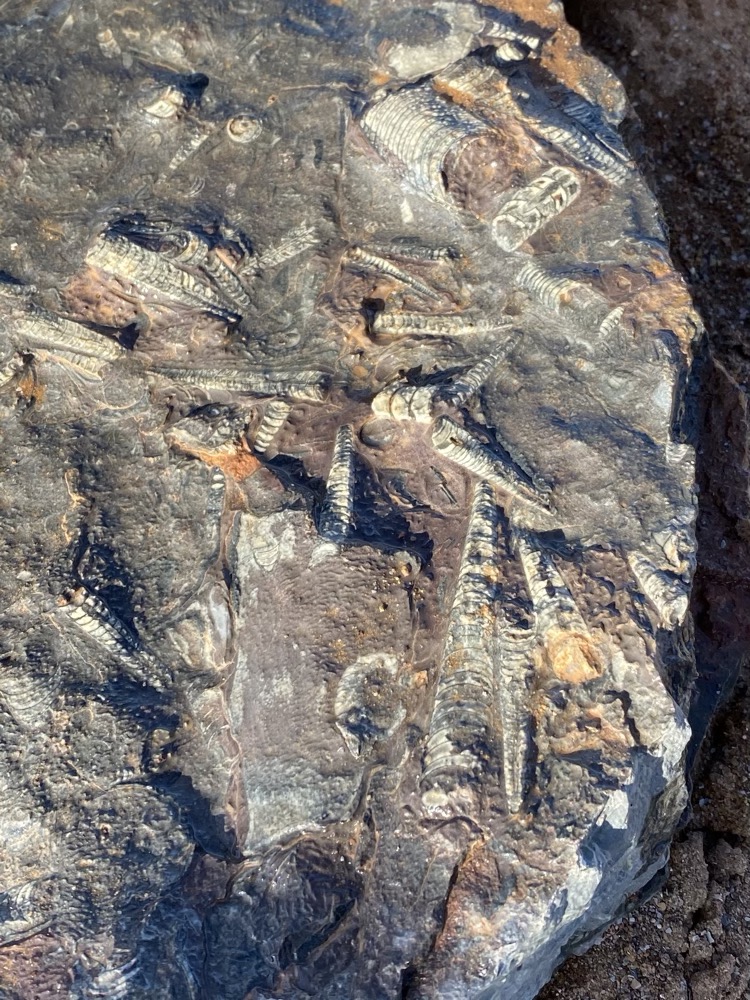 Quite literally, we are in the middle of nowhere and there was a woman herding her goats. We stopped and gave her a jug of water and said a quick ‘hello’ before jumping back in the jeeps to carry on. Not 100m from where this patch of vegetation was, we were back to sand and nothing for her animals to eat.
Quite literally, we are in the middle of nowhere and there was a woman herding her goats. We stopped and gave her a jug of water and said a quick ‘hello’ before jumping back in the jeeps to carry on. Not 100m from where this patch of vegetation was, we were back to sand and nothing for her animals to eat. We followed this enormous rock ridge for what seemed like about two hours. Every time we thought we were going to pass it, we just turned the corner to be greeted with another rocky face.
We followed this enormous rock ridge for what seemed like about two hours. Every time we thought we were going to pass it, we just turned the corner to be greeted with another rocky face.
 The last hour in the 4WDs was about as rocky and bumpy as I’ve ever encountered. I spent many months camping and driving in the outback with Mum and Dad as a kid, but never were we thrown around like this – my Dad was usually driving and he was always super careful of the car, slowing down for bad conditions. Our driver Mohammed was super proficient, but they definitely seemed in a hurry, so we were jostled around a LOT. By the time we got off the 4WD, I felt like I’d spent the last hour in a washing machine.
The last hour in the 4WDs was about as rocky and bumpy as I’ve ever encountered. I spent many months camping and driving in the outback with Mum and Dad as a kid, but never were we thrown around like this – my Dad was usually driving and he was always super careful of the car, slowing down for bad conditions. Our driver Mohammed was super proficient, but they definitely seemed in a hurry, so we were jostled around a LOT. By the time we got off the 4WD, I felt like I’d spent the last hour in a washing machine.
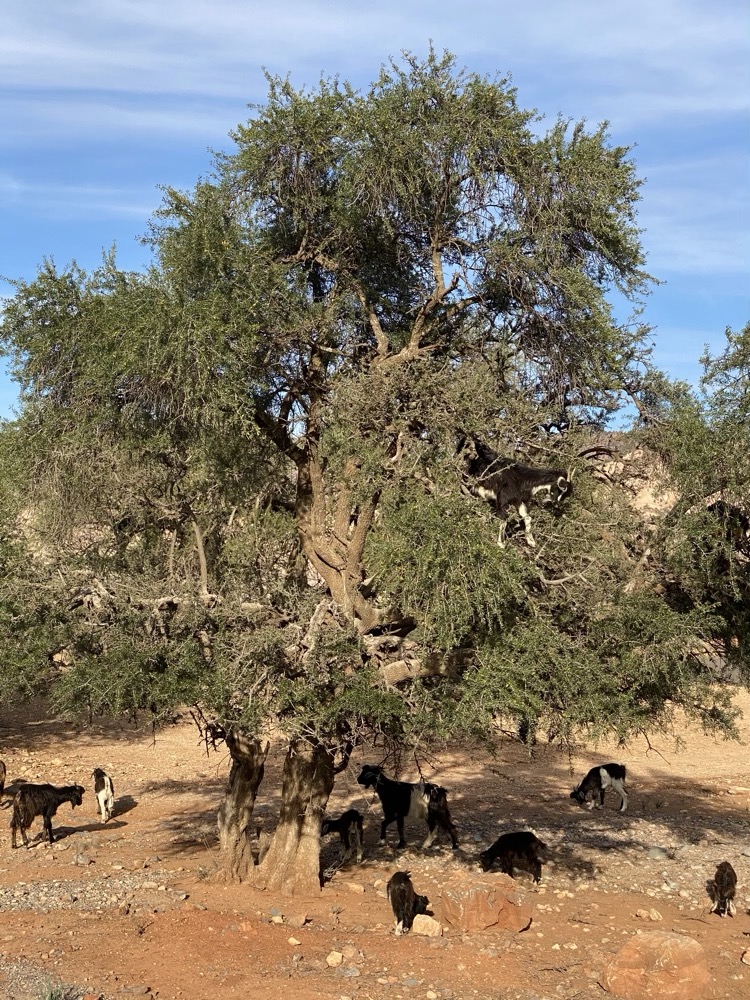 During periods of drought, the goats will abandon foraging on the ground and instead climb the trees to eat the leaves. The goat herders don’t have a problem with this, extra sustenance for their goats, and the farmers who own the trees also don’t have a problem with this, as the goats don’t eat the fruit. The tourists, well they just love the goats in the argan trees, as it is something so typically associated with Morocco.
During periods of drought, the goats will abandon foraging on the ground and instead climb the trees to eat the leaves. The goat herders don’t have a problem with this, extra sustenance for their goats, and the farmers who own the trees also don’t have a problem with this, as the goats don’t eat the fruit. The tourists, well they just love the goats in the argan trees, as it is something so typically associated with Morocco. Samirr made a point of telling us that we were very lucky to see the goats in the trees, at this time of year, they’ve usually had more rain which would mean plenty of easy foraging for the goats and no need to climb trees. However, this summer was pretty dry, so – goats in trees. He claimed about 1 in 5 times he comes through here, they are actually in the trees. Most of the time they are on the ground. So we got lucky.
Samirr made a point of telling us that we were very lucky to see the goats in the trees, at this time of year, they’ve usually had more rain which would mean plenty of easy foraging for the goats and no need to climb trees. However, this summer was pretty dry, so – goats in trees. He claimed about 1 in 5 times he comes through here, they are actually in the trees. Most of the time they are on the ground. So we got lucky. They’re super cute but you have to keep your distance when they jump down, they damn near fly and seem to leap about 3-4m from the branch they’re standing on. Moroccan Drop Goats, we were calling them.
They’re super cute but you have to keep your distance when they jump down, they damn near fly and seem to leap about 3-4m from the branch they’re standing on. Moroccan Drop Goats, we were calling them.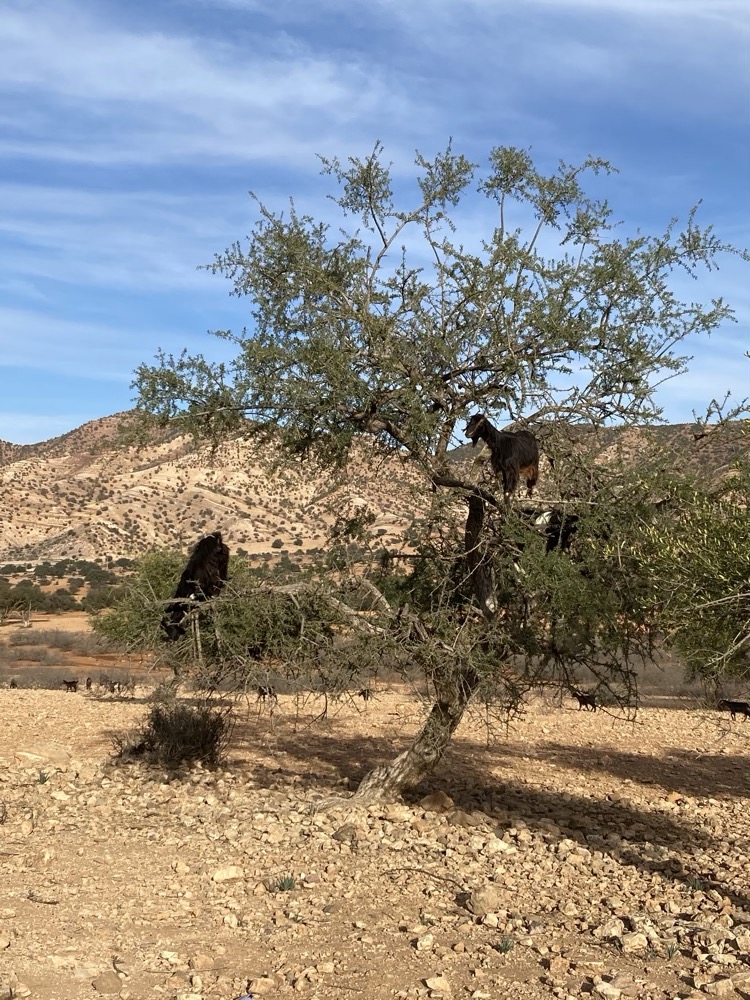 Eventually, we reached our destination of Oulad Berhil which is a tiny town that has barely one taco stand! Much to The Boys’ dismay. It is actually about 45kms from the town of Taroudant, which we will be having a look around tomorrow morning. We were staying overnight in a restored palace which has now been converted to a classy Riad. The palace has owned for the last thirty years by a Danish millionaire who allegedly was overwhelmed by the beauty of the palace and its magnificent gardens. Coming to the Riad Hida is like stepping into another era and still bears the name of the Pasha who built it in the 19thC. The hotel is filled with lounges, furnishings and elegant rooms with gorgeous carved and painted ceilings and an immaculately maintained garden, full of orange trees, swimming pools and peacocks strutting about. The place is lovely and we had an enormous big suite with a huge bed. The door to our suite.
Eventually, we reached our destination of Oulad Berhil which is a tiny town that has barely one taco stand! Much to The Boys’ dismay. It is actually about 45kms from the town of Taroudant, which we will be having a look around tomorrow morning. We were staying overnight in a restored palace which has now been converted to a classy Riad. The palace has owned for the last thirty years by a Danish millionaire who allegedly was overwhelmed by the beauty of the palace and its magnificent gardens. Coming to the Riad Hida is like stepping into another era and still bears the name of the Pasha who built it in the 19thC. The hotel is filled with lounges, furnishings and elegant rooms with gorgeous carved and painted ceilings and an immaculately maintained garden, full of orange trees, swimming pools and peacocks strutting about. The place is lovely and we had an enormous big suite with a huge bed. The door to our suite.
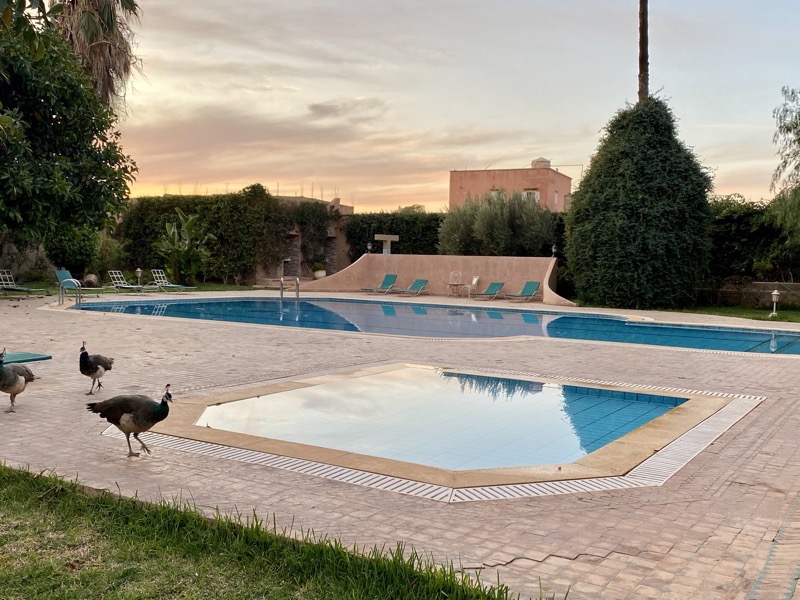







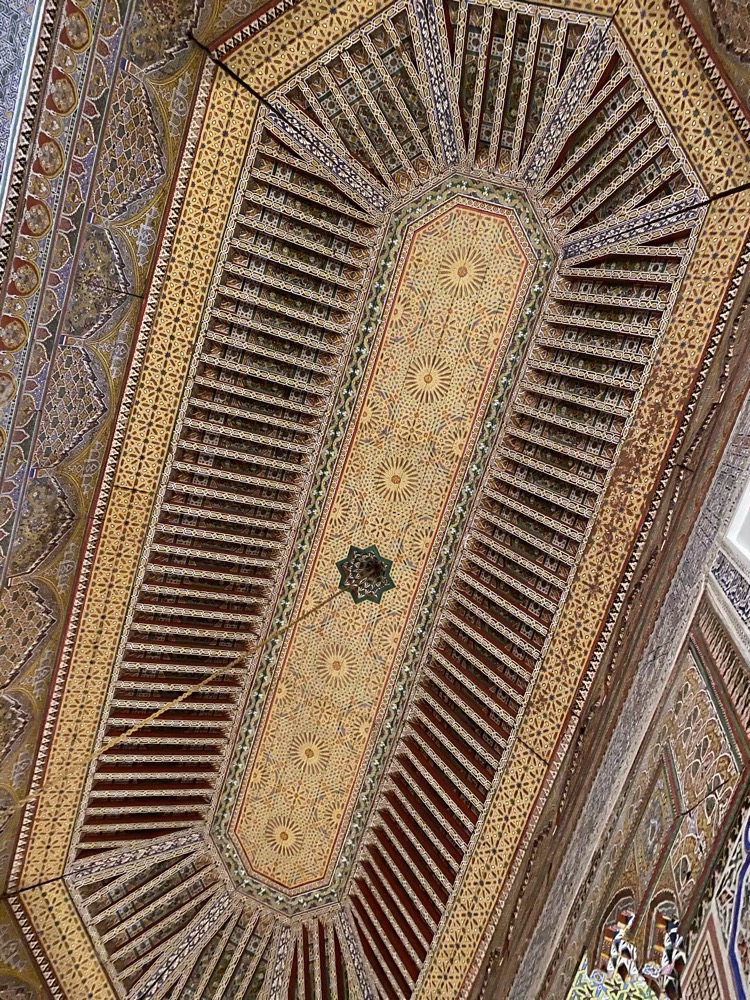
 Dinner was in a lavish restaurant filled with antiques and elegantly decorated. Tagines all round! Our favourite kefta tagine was on the menu, though sadly lacking in eggs.
Dinner was in a lavish restaurant filled with antiques and elegantly decorated. Tagines all round! Our favourite kefta tagine was on the menu, though sadly lacking in eggs. 
